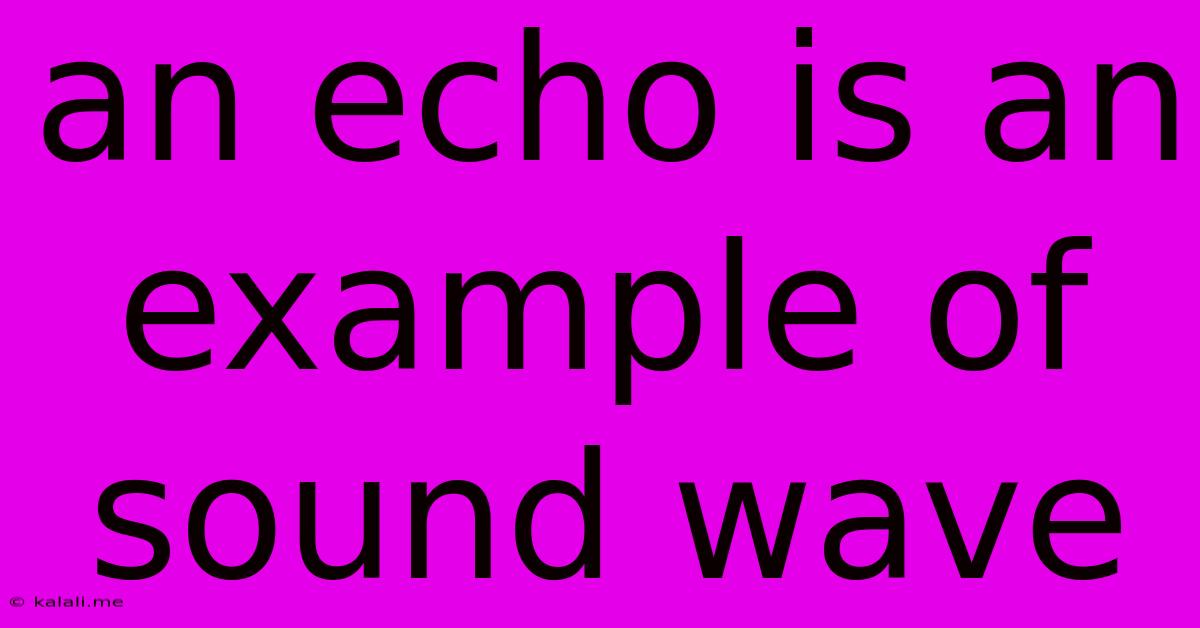An Echo Is An Example Of Sound Wave
Kalali
May 09, 2025 · 3 min read

Table of Contents
An Echo: A Perfect Example of Sound Waves in Action
Have you ever shouted into a canyon and heard your voice bounce back? That echoing sound is a fantastic demonstration of how sound waves behave. This article will explore the physics behind echoes, explaining how they are created and what factors influence their characteristics. Understanding echoes provides a clear and engaging way to grasp the fundamental principles of sound wave propagation.
What is a Sound Wave?
Before delving into echoes, let's establish a basic understanding of sound waves. Sound is a form of energy that travels as longitudinal waves. This means the particles in the medium (like air, water, or solids) vibrate parallel to the direction the wave is moving. When something makes a sound – a person speaking, a car horn honking, or a musical instrument playing – it creates these vibrations, causing compressions and rarefactions (areas of high and low pressure) that propagate outwards. The speed of sound depends on the properties of the medium; sound travels faster in denser mediums.
The Echo Phenomenon: Reflection of Sound Waves
An echo occurs when a sound wave encounters a hard surface, such as a cliff face, a building, or even a dense forest. Instead of being absorbed by the surface, the sound wave reflects or bounces back towards the source. This reflected wave is what we perceive as an echo. The time delay between the original sound and the echo depends on the distance to the reflecting surface and the speed of sound.
Factors Affecting Echoes:
Several factors influence the characteristics of an echo:
- Distance to the reflecting surface: The further the reflecting surface, the longer the time delay before the echo is heard.
- Surface properties: Hard, smooth surfaces like concrete or stone reflect sound more effectively than soft, porous surfaces like carpet or vegetation. This affects the intensity (loudness) of the echo. Rough surfaces can cause scattering of the sound waves, resulting in a weaker or less distinct echo.
- Sound frequency: Higher frequency sounds tend to be absorbed more readily than lower frequency sounds. Therefore, echoes of higher pitched sounds may be less pronounced.
- Environment: Environmental factors like wind, temperature, and humidity can also affect the propagation of sound waves and consequently the quality of the echo.
Beyond Simple Echoes: Reverberation and Multiple Reflections
While a single, distinct echo is easily recognizable, often we hear a more complex sound phenomenon called reverberation. Reverberation occurs when sound waves reflect multiple times off various surfaces within an enclosed space, creating a lingering effect. Think of the sound in a large, empty hall or cathedral. This is caused by numerous reflections overlapping, resulting in a sustained sound rather than distinct echoes. Understanding reverberation is crucial in designing concert halls or recording studios where sound quality is paramount.
Echolocation: Nature's Use of Sound Reflection
Echolocation is a fascinating example of how animals use sound reflection for navigation and hunting. Bats and dolphins, for example, emit high-frequency sounds and then use the returning echoes to "see" their surroundings, detecting obstacles and prey. This biological application of sound wave reflection beautifully demonstrates the practical implications of understanding sound wave behavior.
Conclusion:
The simple phenomenon of an echo serves as a powerful illustration of fundamental principles in acoustics. By observing and analyzing echoes, we gain a deeper understanding of how sound waves travel, reflect, and interact with their environment. This knowledge has far-reaching applications, from architectural design to sophisticated technologies like sonar and echolocation. Understanding echoes allows for a clearer understanding of the intricate world of sound.
Latest Posts
Latest Posts
-
How Many Cups Is 1 5 Ounces
May 09, 2025
-
Compare And Contrast Mesopotamia And Egypt
May 09, 2025
-
Is A Measure Of The Energy In A Wave
May 09, 2025
-
How Much Is 40 Ml Of Water
May 09, 2025
-
What Is 3 8 As A Mixed Number
May 09, 2025
Related Post
Thank you for visiting our website which covers about An Echo Is An Example Of Sound Wave . We hope the information provided has been useful to you. Feel free to contact us if you have any questions or need further assistance. See you next time and don't miss to bookmark.